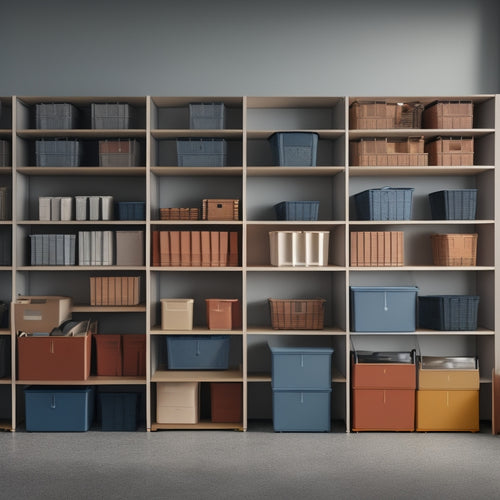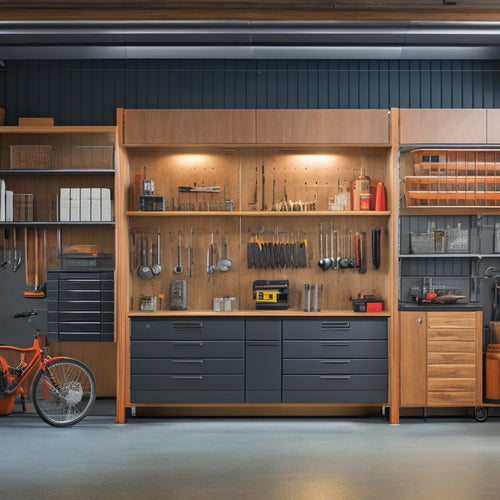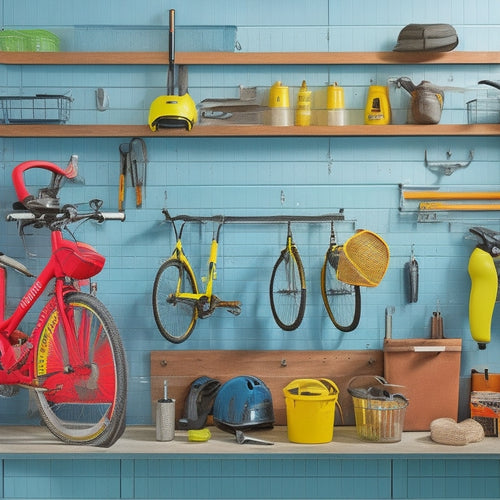
10 Essential DIY Tool Storage Hacks for Beginners
Share
You're about to transform your workspace into a highly efficient and organized area with these essential DIY tool storage hacks. Repurpose old furniture into functional storage units, and utilize magnetic strips to hang frequently used tools. Build a pegboard system tailored to your tool collection, and create a portable toolbox for on-the-go projects. Maximize vertical space with DIY shelving, and make the most of ceiling space with hanging hooks and bins. With these hacks, you'll be able to find what you need in seconds, saving you time and reducing frustration. Now, get ready to take your tool organization to the next level!
Key Takeaways
• Repurpose old furniture into functional storage units, such as transforming dressers into tool storage with bins and baskets.
• Utilize magnetic strips creatively to hang frequently used tools on metal surfaces, considering tool weight and size.
• Build a functional pegboard system by planning the design, categorizing tools, and implementing hybrid storage for flexibility.
• Create DIY shelving solutions for small spaces, such as installing floating shelves or using cube storage units for smaller tools.
• Customize a portable toolbox with dividers, hooks, or pegboards to keep essential tools organized and accessible on-the-go.
Repurposing Old Furniture for Storage
Transform an old dresser or bookshelf into a functional storage unit by removing drawers or shelves and attaching pegboards, hooks, or bins to create a customized DIY tool storage system.
You can upcycle drawers by attaching casters to the bottom and using them as mobile storage containers. Simply remove the drawer slides and attach the casters to the bottom of the drawer. This way, you can easily move your tools around the garage or workshop.
Repurposing cabinets is another great way to create additional storage. Consider removing the doors and attaching pegboards or hooks to the interior. This allows you to hang tools like hammers, screwdrivers, and pliers, keeping them within easy reach.
You can also add bins or baskets to store smaller items like nuts, bolts, and screws. By repurposing old furniture, you'll not only reduce waste but also create a functional and organized tool storage system that meets your specific needs.
With a little creativity, you can turn an old piece of furniture into a valuable storage solution.
Using Magnetic Strips Effectively
You can take your tool storage system to the next level by incorporating magnetic strips, which allow you to hang frequently used tools like wrenches, pliers, and screwdrivers on metal surfaces, keeping them easily accessible and saving valuable space. This is especially useful for smaller tools that can get lost in cluttered drawers or shelves.
Here are some creative ways to use magnetic strips for tool storage:
| Tool | Magnetic Strip Location | Benefits |
|---|---|---|
| Wrenches | Garage wall | Quick access, saves floor space |
| Pliers | Workbench | Keeps frequently used pliers within reach |
| Screwdrivers | Toolbox | Organizes screwdrivers by type and size |
| Drill bits | Drill press | Easy access, reduces clutter |
| Utility knives | Pegboard | Convenient storage, reduces lost knives |
When choosing magnetic strips, consider the weight and size of the tools you want to store. You can also use magnetic strip alternatives, such as adhesive-backed magnets or magnetic hooks, for added flexibility. By incorporating magnetic strips into your storage solutions, you'll be able to find what you need quickly and stay organized.
Building a Tool Pegboard System
Now that you've got your magnetic strips in order, it's time to create a pegboard system that'll keep your tools organized and within reach.
To get started, you'll need to plan your pegboard design, considering the size, layout, and tool placement that works best for your workspace.
Pegboard Design Essentials
To create a functional and efficient tool pegboard system, start by planning the layout and determining the best size for your available wall space. Take into account the tools you'll be storing and the frequency of use to ensure easy access. A well-designed pegboard can boost your productivity and reduce clutter in your workspace.
When it comes to pegboard design, don't forget to contemplate the following essential elements:
-
Pegboard color schemes: Choose a color that complements your workspace layout and makes it easy to spot the tools you need. Neutral colors like white, gray, or black are popular choices.
-
Pegboard accessory options: Select accessories that fit your tool organization techniques, such as hooks, bins, and trays. These will help you maximize storage space and keep similar tools together.
-
Workspace layout: Plan the layout of your pegboard to create a logical workflow. Group similar tools together, and place frequently used tools at eye level for easy access.
Tool Organization Strategies
Building a tool pegboard system requires a thoughtful approach to tool organization strategies, starting with categorizing your tools by function, frequency of use, and size to maximize efficiency. This approach helps you identify the most frequently used tools and allocate prime space on your pegboard. To take it a step further, consider implementing a hybrid storage system that combines a pegboard with a tool chest organization system, garage wall storage, or a rolling tool cart for utmost flexibility.
Here's a sample categorization framework to get you started:
| Tool Category | Frequency of Use | Storage Location |
|---|---|---|
| Hand tools (hammers, screwdrivers) | High | Pegboard |
| Power tools (drills, saws) | Medium | Tool chest |
| Seasonal tools (lawn mower, snow blower) | Low | Outdoor tool storage |
| Measuring tools (tapes, levels) | High | Rolling tool cart |
DIY Shelving for Small Spaces
You'll maximize your small space's storage potential by installing shelves that are tailored to its unique dimensions and needs. This is especially important when it comes to DIY tool storage, as cluttered workspaces can lead to decreased productivity and increased frustration.
To make the most of your small space, consider the following DIY shelving ideas:
-
Floating shelf ideas: Install floating shelves to create the illusion of more space while keeping frequently used tools within easy reach.
-
DIY cube storage: Build or purchase cube storage units that can be mounted on walls or placed on floors to store smaller tools and accessories.
-
Wall mounted shelves: Take advantage of vertical space by installing wall-mounted shelves that can hold bins, baskets, or other storage containers.
Creating a Portable Toolbox
Craft a portable toolbox that follows you wherever your DIY projects take you, keeping essential tools and supplies organized and within arm's reach. A portable toolbox is perfect for beginners who work on multiple projects simultaneously or need to move around the house or yard.
You can repurpose an old tool chest or invest in a new one that fits your needs. Consider a rolling cart with drawers or compartments to keep your tools and supplies categorized and easy to access.
When selecting a portable toolbox, think about the size, weight, and mobility. You want a toolbox that's easy to carry or roll around, yet sturdy enough to hold your tools. Look for features like sturdy handles, smooth-rolling wheels, and a durable design.
You can also customize your portable toolbox by adding dividers, hooks, or a pegboard to maximize storage space. With a portable toolbox, you'll be more efficient and productive, and your DIY projects will be a breeze to complete.
Maximizing Garage Corner Storage
Now that you've got your portable toolbox in order, it's time to turn your attention to another often-wasted space: the garage corner, where clutter tends to accumulate and valuable storage space goes unused.
Don't let this area become a dumping ground for miscellaneous items. Instead, maximize its potential with these garage organization hacks.
-
Install corner shelving: This will provide a dedicated space for storing bins, baskets, or even small tools. Look for adjustable shelves that can be customized to fit your specific needs.
-
Utilize the back of the wall: Take advantage of the often-overlooked space on the back of the garage wall by installing hooks, a pegboard, or a slatwall. This will keep items like bikes, tools, and accessories organized and within reach.
-
Incorporate a carousel: A rotating carousel is perfect for storing items like paint cans, cleaning supplies, or other small containers. This will keep them organized, visible, and easily accessible.
Utilizing Overhead Ceiling Space
When it comes to storing tools, you're likely not thinking about the space above your head. However, you can reclaim that overhead ceiling space by maximizing your vertical real estate.
Maximize Vertical Real Estate
Hang bulky items like bikes, kayaks, or large toolboxes from the ceiling to free up floor space and create a more organized workshop. This will give you more room to move around and reduce clutter. By maximizing your vertical real estate, you'll be able to store more items without sacrificing precious floor space.
Here are three ways to make the most of your ceiling space:
-
Tool belt organization:
Install hanging hooks to store your tool belts, keeping them organized and within easy reach. -
Vertical tool rack:
Mount a vertical tool rack on your wall to store long-handled tools like shovels, rakes, and hoses. -
Wall mounted bins:
Use wall-mounted bins to store smaller items like screws, nuts, and bolts, keeping them organized and out of the way.
Install Adjustable Tracks
How can you optimize your overhead ceiling space to accommodate a wide range of tools and equipment without cluttering your workshop floor?
By installing adjustable tracks, you can create a versatile and efficient storage solution that keeps your tools within easy reach. This DIY track system allows you to customize your storage needs, making it perfect for beginners.
With adjustable tracks, you can store items of varying sizes and weights, from bins and baskets to toolboxes and accessories. The tracks are easy to install and can be adjusted as your storage needs change.
This track organization system keeps your workshop floor clear, reducing tripping hazards and creating a safer working environment.
Customizing a Toolbox Organizer
You can transform a basic toolbox organizer into a tailored storage solution by adding dividers, labels, and accessories that cater to your specific tool collection and workflow. This customization will help you maximize your toolbox's potential and make your work more efficient.
To get started, consider the following essential customization elements:
-
Dividers: Separate your tools into categories, such as hand tools, power tools, and fasteners, to prevent clutter and make them easier to find.
-
Labels: Identify each compartment or section with clear labels, so you can quickly locate the tool you need.
-
Accessories: Add tool-specific holders, such as a hammer hook or screwdriver tray, to keep frequently used tools within easy reach.
Hacking a Pegboard for Hand Tools
By attaching pegs, bins, and hooks to a pegboard, you can create a customizable storage system that keeps your hand tools organized, visible, and within easy reach. This hack is especially useful for DIY garage or workshop enthusiasts who want to maximize their wall storage.
With a pegboard, you can practice tool shadowing, where each tool has a designated spot, making it easy to find what you need when you need it. You can also install a pegboard on the back of a tool chest or cabinet to create additional storage space.
To get started, choose a pegboard that fits your available wall space and the type of tools you need to store. Then, select the pegs, bins, and hooks that fit your tools. You can find a variety of accessories specifically designed for pegboards, from small bins for screws and nuts to large hooks for hammers and wrenches.
Organizing Small Parts and Fasteners
Small parts and fasteners, like screws, nuts, and bolts, can quickly clutter your workspace, making it difficult to find what you need when you need it. To avoid this chaos, you need a solid organization system in place.
Here are three essential tips to help you get started:
-
Create a labeling system: Use labels to identify what's inside your containers or drawers. This way, you can easily find what you're looking for without having to dig through everything.
-
Use drawer dividers and stackable containers: Divide your drawers into sections using dividers, and store small parts in stackable containers. This will keep similar items together and prevent them from getting mixed up.
-
Invest in screw organizers: Screw organizers are specifically designed to hold small screws, nuts, and bolts. They usually have separate compartments and can be mounted on a wall or placed in a drawer.
Frequently Asked Questions
How Do I Prevent Rust on Metal Tools in Storage?
"As you tenderly place your metal tools in storage, rust creeps in like an unwanted guest. You can evict it by controlling moisture with silica gel packets or rust-inhibiting coatings, ensuring your tools remain in pristine condition."
Can I Store Power Tools With Lithium-Ion Batteries?
You can store power tools with lithium-ion batteries, but prioritize battery maintenance and safety by following proper charging habits, like avoiding overcharging and storing them in a cool, dry place.
What Is the Ideal Storage Temperature for DIY Tools?
When storing DIY tools, you'll want to maintain an ideal storage temperature between 60°F to 70°F (15°C to 21°C), with ideal humidity levels around 40-50%, and guarantee proper ventilation to prevent moisture buildup and damage.
How Often Should I Clean My Tool Storage Containers?
'Just like a well-oiled machine, your tool storage containers need regular cleaning to maintain their effectiveness. You should clean them every 3-6 months, following organizing tips to guarantee everything stays in its place and functions smoothly.'
Are DIY Tool Storage Solutions Suitable for Rented Homes?
When renting, you'll want temporary solutions that won't damage the property. Opt for space-saving ideas like portable toolboxes or hanging organizers that can be easily removed when you move out, ensuring you get landlord approval.
Related Posts
-

Choosing the Right Stacked Storage Bins
When choosing the right stacked storage bins, you'll want to evaluate your storage needs, considering inventory types...
-

Best Materials for Garage Wall-Mounted Cabinets
When selecting materials for your garage wall-mounted cabinets, you'll want to evaluate options that balance durabili...
-

Benefits of Pegboard Racks in Your Garage
By installing a pegboard rack in your garage, you'll reveal a wealth of benefits that change your workspace into a hi...


